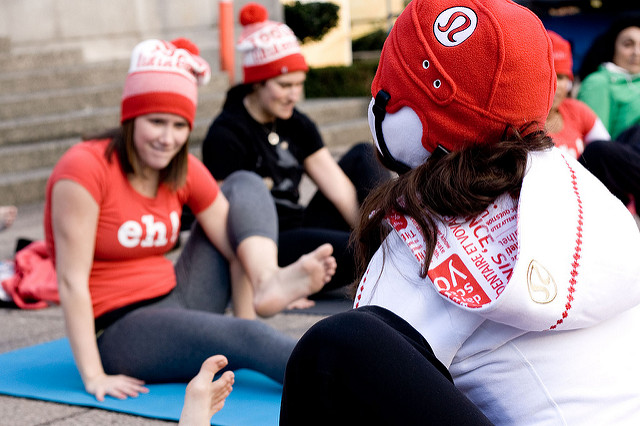Unlock the Magic in Your Story Now
Get the Free 20 questions to Ask Before Launching Your Idea workbook when you sign up for occasional updates.
Get the Free 20 questions to Ask Before Launching Your Idea workbook when you sign up for occasional updates.
The Purpose Of Clever Packaging
filed in Marketing, Storytelling, Strategy
 If you love chocolate as much as I do you’ve probably heard about the Mast Brothers scandal.
If you love chocolate as much as I do you’ve probably heard about the Mast Brothers scandal.
The artisan chocolate makers are accused of not being completely transparent about their process when they launched in 2007 and of pulling the wool over customers eyes with “clever packaging”.
Transparency aside for a moment, because of course what’s inside the wrapper has to fulfil the promise the packaging makes. Packaging should be clever and intentional. If we’re not deliberately trying to create a connection with our customers in everything we do then what’s the point? Wrappers are the opening line of the brand story.
The ‘once upon a time’. The first thing the customer notices, touches and experiences.
The story we give her to tell, (often to herself).
The inconspicuous red sole of a Christian Louboutin shoe. The encouraging manifesto on a Lululemon bag. The highly researched and purposefully created unboxing experience of an Apple product. And yes, the gorgeous paper on a Mast Brothers chocolate bar—all clever packaging that customers are happy to pay for because of how it makes them feel.
Intangible value is something customers crave. The question packaging design must address isn’t how to charge more for average stuff, it’s how to change what the customer feels.
Image by Jen Collins.
Share this article
The Alternative To Winning The Awareness Game
filed in Marketing, Storytelling, Strategy
 The top 200 advertisers in the U.S. spent $137.9 Billion on ads in 2014. When you’ve got those resources it’s easy to play the awareness game.
The top 200 advertisers in the U.S. spent $137.9 Billion on ads in 2014. When you’ve got those resources it’s easy to play the awareness game.
What if newspaper presses came to a stop and banner ads were abolished on the grounds of inciting mindless consumption? Imagine a world where billboards were torn down to combat visual pollution and TV channels stopped interrupting programs with commercials.
What would our options to woo our customers be then?
There is more than one way to become both top of mind and close to heart. Patagonia employs 45 full time technicians to repair customer’s old and damaged clothing for free. Warby Parker offers a 5 day home try-on service. Tenzing Men’s Skincare sends free samples to prospective customers. Our local cafe invests in staff training to ensure that customers experience the best service in the world. Lululemon holds complimentary yoga classes and events. And these businesses link their sales to giving impacts with the help of B1G1.
What could you commit part of your advertising budget to in order to get closer to your customers?
Image by Shinsuke Ikegame.
Share this article
Meaningful Work
filed in Storytelling, Strategy
 We’ve all witnessed a version of this in action. The speciality restaurant vowing to serve free range, grass fed and organic. The gift shop committed to selling local and artisanal. The designer who refuses to work with fast food companies. Uncompromising—until they think about scaling or they hit a bump in the road of their business.
We’ve all witnessed a version of this in action. The speciality restaurant vowing to serve free range, grass fed and organic. The gift shop committed to selling local and artisanal. The designer who refuses to work with fast food companies. Uncompromising—until they think about scaling or they hit a bump in the road of their business.
Staying committed to your intention, keeping the promises you made to the people you serve (and to yourself)—choosing to amplify your difference is at the heart of meaningful work.
What makes a compelling brand, an unforgettable book, or a piece of music that moves us is what the creator has chosen to leave out. The silence between two notes.
As the composer Gustavo Santaolalla said, “Not playing is sometimes more difficult.”
Knowing which notes to play is what makes all the difference.
Our job isn’t to play every possible note.
It’s to play one note every day that we’re proud to have played.
[And often to enable other people to do the same.]
Image by Timothy V.
Share this article
The Moments In Between
 On a recent international flight, a colleague was upgraded from Business Class to First Class.
On a recent international flight, a colleague was upgraded from Business Class to First Class.
The four cabin crew had only eight passengers to look after, so they could be extra attentive. The in-flight service was stellar. Everything happened quickly and smoothly, the menu was more varied and the seats more comfortable.
But for all of that by the end of the journey, he concluded that there’s very little to differentiate one experience from the other while you’re in the air. A lot of the value is created before boarding and after landing—during the moments in between. What made flying First Class exceptional was the seamlessness of the experience while on the ground. No queueing at passport control (the immigration officials come to you), beautiful lounges to freshen up in between flights and unhurried transfers.
We devote most of our energy and resources to delivering spec—on the things customers should expect from us, but it’s the moments in between where we have the opportunity to excel, differentiate and delight.
Where are your moments in between? How can you use them to give the customer a story to tell?
Image by simplethrill.
Share this article
7 Steps To Becoming A More Strategic Marketer
 As marketers we spend much of our time and energy on tactics. We agonise over the creation of lead magnets, spend countless hours honing sales pages and perfecting social media promotions.
As marketers we spend much of our time and energy on tactics. We agonise over the creation of lead magnets, spend countless hours honing sales pages and perfecting social media promotions.
How To Become A More Strategic Marketer
1. Take a long-term view of your business, one that doesn’t require you to go for quick wins.
2. Find a group of people you care about serving.
3. Listen to what they say and watch what they do.
4. Create a product or service you believe in, one that solves problems and satisfies wants and needs.
5. Trust the people you made it for.
6. Stop selling to and start connecting with people, talk about why you made what you made.
7. Rinse and repeat.
There’s nothing more magnetic to your potential customers than the feeling of being seen and understood. That’s the number one job of your marketing.
Image by Don Harder.
Share this article
The Power Of Customer Context
filed in Marketing, Storytelling, Strategy
 There’s a tiny hole-in-the-wall florist in the heart of the city, close to big office buildings and the cafes where people meet for breakfast and lunch. If it were an ordinary florist it would be the kind of place people would walk past on their way to somewhere else.
There’s a tiny hole-in-the-wall florist in the heart of the city, close to big office buildings and the cafes where people meet for breakfast and lunch. If it were an ordinary florist it would be the kind of place people would walk past on their way to somewhere else.
The neighbouring florist’s made-to-order, elaborate, cellophane-wrapped bouquets don’t cater to commuting office workers who live in small apartments on modest budgets. Meanwhile, the hole-in-the-wall sells out of simple, inexpensive, glass jars filled with wildflowers. The owner understands the power of the context in which the customer experiences his brand and how his product fits into her story.
There’s no need to second-guess the gesture of buying a little bunch that’s perfect for cheering up the corner of a desk on Monday morning (no vase or pre-ordering required), and no excuse not to celebrate the start of the weekend on the way to the tram on Friday night.
The more we put the customer at the centre of our marketing, the more we leave room for their story, the better our results will be. How are you doing that?
Image by mimmyg.
 When we market our products to customers we often use a persuasive tone designed to convince. We describe by leading with features and benefits. We try hard to give customers reasons to choose, forgetting that most purchasing decisions are not rational, but emotional.
When we market our products to customers we often use a persuasive tone designed to convince. We describe by leading with features and benefits. We try hard to give customers reasons to choose, forgetting that most purchasing decisions are not rational, but emotional. How is it that we can go into the same cafe two days running, order the same drink, pay the same price and yet leave feeling entirely different about the experience depending on the interaction we have with the person who is serving?
How is it that we can go into the same cafe two days running, order the same drink, pay the same price and yet leave feeling entirely different about the experience depending on the interaction we have with the person who is serving? Grace is 32 years old, she has worked hard to establish herself on the career ladder and bought her first home. Grace and her partner Mike are trying for a baby. As marketers with a brand story to tell we’re in a hurry to gather as much data as we can about Grace. We want to know her postcode, where she shops and what she chooses. We want to know how much she earns and how many people live in her household. Of course, there are companies, algorithms and applications that can filter this data for us.
Grace is 32 years old, she has worked hard to establish herself on the career ladder and bought her first home. Grace and her partner Mike are trying for a baby. As marketers with a brand story to tell we’re in a hurry to gather as much data as we can about Grace. We want to know her postcode, where she shops and what she chooses. We want to know how much she earns and how many people live in her household. Of course, there are companies, algorithms and applications that can filter this data for us. Every day you delete messages received from faceless SEO companies who have “noticed you could have a lot more hits to your website”. We are often mistakenly led to believe that our biggest challenge is getting more people to pay attention to our products, services or work.
Every day you delete messages received from faceless SEO companies who have “noticed you could have a lot more hits to your website”. We are often mistakenly led to believe that our biggest challenge is getting more people to pay attention to our products, services or work.